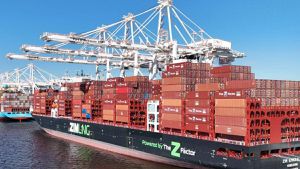Nasa has made significant strides in its Artemis program, aimed at returning humans to the Moon. The space agency recently announced the successful delivery of critical components for the Space Launch System (SLS) rocket, which is essential for upcoming crewed missions to the Moon. This comes as Nasa prepares for the Artemis II mission, set to launch in September 2025, marking the first human flight to lunar orbit since 1972.
The arrival of the core stage of the SLS at Kennedy Space Center, Florida, represents a pivotal moment in the Artemis initiative. "The core is the backbone of SLS, and it’s the backbone of the Artemis mission," stated Matthew Ramsey, Nasa’s mission manager for Artemis II. With this core stage, teams can initiate the rigorous integration and testing processes required before astronauts Reid Wiseman, Victor Glover, Christina Koch, and Jeremy Hansen embark on their historic journey.
Officials stress the importance of thorough testing and checks as the rocket is assembled. The SLS rocket’s two solid rocket boosters, built by Northrop Grumman, along with the upper stage provided by United Launch Alliance, are crucial for the mission's success. "We’ve been waiting for the core to get here because all the integrated tests and checkouts that we do have to have the core stage," Ramsey elaborated. The completion of these processes is essential prior to launching Artemis II, which will orbit the Moon for a duration of ten days.
The Artemis III mission, slated for a target launch in September 2026, aims to land astronauts on the Moon’s south pole for the first time. This location offers unparalleled scientific opportunities, as it is believed to harbor water ice, a vital resource for future lunar exploration and potential long-term stays. The selected landing sites are particularly rich in scientific interest due to their proximity to permanently shaded regions on the lunar surface.
As Nasa gears up for Artemis II and III, other organizations are also making lunar progress. Notably, Intuitive Machines successfully landed its Odysseus spacecraft on the Moon in February 2024—the first American lander in 50 years. This historic landing highlighted growing private sector involvement in space exploration. Intuitive Machines CEO Steve Altemus remarked, "I know this was a nail-biter, but we are on the surface, and we are transmitting. Welcome to the Moon." This private landing underscores a renewed U.S. presence on the lunar surface.
Nasa Administrator Bill Nelson called the successful landing of the Odysseus a "triumph" and emphasized the increasing collaboration between public and private sectors in enhancing lunar exploration. The agency has invested $118 million in putting experiments aboard the Odysseus lander as part of its broader lunar objectives. Nelson described this collaboration as a tremendous step towards a sustainable lunar presence as the agency seeks to establish regular missions to the Moon with plans for a permanent base that could support human habitation.
The lunar south pole locations identified for Artemis III are not only scientifically significant but also strategically selected to ensure adequate sunlight for power needs. Each of the 13 proposed regions allows for both sunlit lander operations and access to shaded areas that might contain valuable lunar resources, such as water ice. Sarah Noble, the Artemis lunar science lead, noted that these sites include some of the oldest portions of the Moon, which could provide insights into its geological history.
NASA's plan extends beyond the Moon; there are aspirations to eventually facilitate human missions to Mars. Part of this extensive roadmap includes collaborations with various private companies, primarily focused on technologies needed for future lander missions and exploration vehicles. Recent decisions have seen Nasa selecting several contractors to develop lunar terrain vehicles that will assist astronauts in exploring the surface of the Moon more effectively. Companies like Intuitive Machines, Lunar Outpost, and Venturi Astrolab will contribute towards creating advanced rovers designed for lunar exploration, signifying a shift towards more robust outreach efforts on the Moon.
"This vehicle will greatly increase our astronauts’ ability to explore and conduct science on the lunar surface while also serving as a science platform between crewed missions," commented Vanessa Wyche, director of NASA’s Johnson Space Center. The anticipated launch of these lunar vehicles aligns with Nasa's vision of gaining enlightenment in various scientific fields, enabling potential breakthroughs in lunar studies and resource utilization.
Year 2029 is earmarked for the operational readiness of the new lunar terrain vehicle, enhancing mission capabilities on the Moon. As teams work diligently on their designs, the goal remains the same: to ensure a state-of-the-art vehicle capable of autonomous operations, advanced navigation, and sustained scientific inquiry.
NASA's unfolding lunar ambitions are ultimately aimed at laying the groundwork for future human existence not just on the Moon, but the eventual exploration of Mars as well. The Artemis program is seen as a educational and cultural endpoint enriching humanity’s understanding of space. This is a crucial time for NASA as it gathers momentum toward shaping a new era in space travel, echoing a powerful legacy of human exploration.



